Ball Reviews
Review: Titleist Velocity and DT SoLo Golf Balls

Pros: The DT Solo provides a soft feel, good greenside control and is a higher launching ball that will fit a lot of different players. The Velocity generated the lowest spin of any ball off the tee and great distance with middle irons.
Cons: The Velocity was not as long as the other 2014 Titleist balls with the driver. Ball speeds with the DT SoLo were slower than others, and the high launch and flight had might be too high for some.
Bottom Line: Both the Velocity and the DT SoLo are designed to launch and fly higher, straighter and longer, which fits the needs of many weekend golfers. The Velocity flies very straight off the tee, generates longer distance off the irons and for a distance ball, has decent feel around the green. The DT SoLo is a more well-rounded, relatively inexpensive ball, that creates a higher ball flight and longer distance than previous models, while also providing impressive control and feel around the greens.
Note: Our scoring of the Titleist DT Solo and Velocity golf balls represents an average score of both balls. Each ball is also scored within its category of golf balls. For detailed scores of each ball, see the end of the review.*
Overview
Next to the Pro V1 and Pro V1X, the 2014 Velocity golf balls seem to get the most airtime these days and most GolfWRX readers probably have “powered for distance” running through their heads after watching PGA Tour coverage. The DT SoLo on the other hand, hardly gets any attention. Both balls have been redesigned for more distance off the tee and a softer feel around the green. The Velocity is a straight up distance ball. However, even though the DT SoLo doesn’t get a ton of love, it has a significant following of golfers, especially golfers with slower swing speeds and those who appreciate playing a reasonably priced, well-rounded golf ball that delivers a softer feel and higher launch.
Just like the NXT Tour and NXT Tour S, the new Velocity and DT SoLo were white-box tested by over 40,000 golfers during Titleist’s testing and validation program. Their feedback helped shape the enhancements to this year’s models.
Velocity
The 2014 Titleist Velocity has a reformulated LSX core which was specifically designed to generate high initial ball speeds for more firepower off the tee and with the long irons. A spherically-tiled 328 tetrahedral dimple design is highly symmetrical, which produces a higher more stable ball flight and a shallower angle of descent for more rollout. The core of the golf ball was softened as well, which creates better feel than previous models.
DT SoLo
The redesigned 2014 DT SoLo focuses on providing longer distances on full shots, while maintaing the soft feel and greenside control that golfers have come to expect from the DT SoLo. The core remains the same with a fast, super soft compression core. A spherically-tiled, 376 tetrahedral dimple design on the soft ionomer cover, create a nice combination of longer distance off the tee, but great feel and spin around the greens.
The Velocity is available now in the traditional white color and comes in single (1-4) and double-digit (00, 11, 22, 33) play numbers. The minimum advertised price is $26.99/dozen.
The DT SoLo, just like the NXT Tour S, is available in both white and high -ptic yellow, which some golfers will find appealing, even those who have not traditionally played a yellow ball. Only available in standard numbering, the DT Solo is available now for a minimum advertised price of $19.99/dozen.
Performance
Unlike the Pro V1 and Pro V1x or the NXT Tour and NXT Tour S, the Velocity and DT SoLo were not designed as a complementary set. They were designed with distinctly different purposes.
The Velocity is a distance ball, while the DT SoLo is a more well rounded ball. Going into performance testing. I assumed each ball would excel in different areas. The Velocity would provide higher ball speeds and more distance, while the DT SoLo would launch higher, fly a bit shorter, but also generate more spin.
My testing methodology was the same as other reviews in this series. I tested both balls on a launch monitor and on the course. To get the data, I hit both balls on a launch monitor with a 60-degree wedge, 6 iron and a driver. My playing swing speed with a driver is around 105 mph and I try to maintain a stock playing swing throughout testing. Since the preferred ball for my game is the Pro V1X, the charts below show the data relative to the performance of the Pro V1X. Following Titleist’s fitting process, we’ll start near the green and work back.
60-degree Wedge Full Shots
Going into the wedge testing, I assumed that the Velocity would generate significantly less spin than any of the other balls in the 2014 lineup. According to Titleist, the difference in rpm between its lowest-spinning and highest-spinning balls for shots around the green will be at least greater than 1,500 rpms. From the tee, it’s less than 500 rpm. In my testing, the Velocity generated substantially less spin, 4,705 rpm less, on average than the Pro V1X. Comparing the spin to the DT SoLo, The Velocity still managed to spin 2,120 rpms less. While there were some higher spinning shots than the average, most of the shots fell right around the average spin generated. The Velocity did however, launch over 5-degrees higher and hit a peak height of 4 yards higher than the Pro V1X. This allowed the balls to come in a bit steeper for me and have a better chance of holding the green.
I have a lot of respect for the DT SoLo, not just with the wedge but through the bag. Focusing on the wedge data for the moment, the DT SoLo created a great deal of spin for a ball in its category. In fact, the average spin was regularly greater than 8,000 rpm and many shots spun their way up into the mid 9,000s. Launch angle was 2.4-degrees higher than the Pro V1x and the peak height, just like the Velocity, was 4 yards higher on average.
6-Iron Shots
I was eager to see how the Velocity would shine with a 6 iron now that we are moving more into the ball’s wheelhouse. Right off the bat, I could tell the Velocity was going to produce more distance with the irons than the other balls, and while it wasn’t a huge difference, the Velocity ended up 3 yards longer on average. The peak height was only 1 yard higher than the Pro V1X with the same descent angle but more rollout, which backed up Titleist’s claims. Interestingly, the Velocity also generated the least amount of side spin, only -20 rpm on average, which proves that this is a very straight ball. Additionally, I was able to launch the ball 2-degrees higher with the Velocity, which will help many golfers who might struggle to get height from their middle irons.
The DT SoLo continued to perform well with the 6 iron. Overall ball speed continued to be slightly less than the others in the lineup, but distance remained very similar. Spin numbers were only slightly less than the NXT Tour, but the launch angle and peak height were the highest of any of the 2014 Titleist balls. Even more so than the Velocity, the high-launching, high-flying DT SoLo will be a great option for golfers who struggle to get height from their shots throughout the bag.
Driver Shots
Now is the time for the Velocity to shine. Titleist’s big claim with the Velocity is more distance off the tee leading to shorter approach shots. But for me, I didn’t see a significant gain in distance compared to the other balls. Overall, the Velocity was not the longest ball in the lineup, that honor went to the NXT Tour. That said, just like the 6 iron, the Velocity produced the least amount of side spin at only 57 rpm on average. This is very important for players who generate too much side spin off the tee. The Velocity also launched 1.6-degrees higher — second highest behind the DT SoLo — which will aide golfers in getting the ball up in the air. The combination of the low side spin, plus the higher launch, should help produce straighter, longer drives for many players.
Once again, the DT SoLo continued to perform exactly as I expected it would, launching and flying higher and with a little more spin than the other balls. It was the highest launching ball, almost 2.5-degrees higher than the Pro V1X, reached a peak height of 4 yards higher and had a steeper descent angle. As a result, the DT SoLo produced the least amount of distance for me off the tee, but still fell within the 4-to-6 yard range Titleist claims. While it wasn’t the best ball for my game, I do think the higher-launching, higher-flying DT SoLo is perfect for many golfers seeking to get the ball in the air, without sacrificing feel and control around the greens.
On-Course Testing
Launch monitor data confirmed and backed up most of Titleist’s claims about the expected performance of both golf balls. Just as I did with the other golf balls in this review series, I completed the on-course testing during the same week at River Strand Golf & Country Club.
I played both balls during somewhat calm but gusty conditions over the course of two days. Starting with the DT SoLo, the launch monitor data was confirmed after the first hole of the day. I caught a good drive, but the distance wasn’t quite as far as I would’ve expected. The higher flight, which was very apparent, came back to hurt me in the windy conditions. Shots with the driver and irons got up in the wind a bit higher than I would’ve liked. I was able to adjust and control the height to a certain extent by hitting more knock down shots, but these balls want to get in the air. That said, the combination of the higher launch, flight and spin created a ball that dropped on the green and stayed very close to my pitch mark. I was also able to put a little spin on a bunker shot and hit a couple low checking pitch shots.
The Velocity performed like a distance ball for me. The launch appeared a bit higher than the Pro V1X, but nothing substantial. I hit a couple very nice, straight and long shots with the hybrid. Around the greens, however, the performance wasn’t as good. Approach shots rolled out more than with the other balls, and I had to consciously play for rollout instead of throwing pitches all the way to the hole. These are specific modifications I would have to make for my game. I had a couple friends in my foursome play the Velocity as well and they were very impressed with the distance they were seeing. In the limited time they had with the ball, it seemed to perform how they would expect a distance ball to perform.
Half Wedge Shots
Just as I did with the other 2014 balls, I wanted to give the Velocity and DT SoLo a more thorough test. The Velocity continued to behave like a distance ball, although they did show a little more stopping power than I expected. I was able to hit low spinning shots with the Velocity that flew a bit higher than the Pro V1X or NXT Tour, but when they hit the green would bounce, check up slightly and then roll out a few feet. They didn’t hit and stop, but they also didn’t skip over the green either.
With the DT SoLo, I felt like I had more options than with the Velocity. I could hit the low, spinning half wedge shots I like to hit, which also flew a bit higher but hit the green, bounced, checked a bit and stopped. I found I could also use the higher flight of the DT SoLo to throw some shots up in the air and land them very softly. This option will come in handy when the pin is tucked in tight and there isn’t much room to land the ball and keep it close.
Around the Green
I knew I would, but I had to stomp on wedge shots to get some spin out of the Velocity around the greens. I usually like to be aggressive with my chip shots, but I needed to back off and play more runners with these balls. I don’t think that is a bad thing at all, as most players gaming a distance ball are already playing shots around the green that run out. They expect to hit those shots and for that type of golfer, the Velocity will continue to perform as expected around the greens.
With the DT SoLo, I was able to get a nice check on the ball. Just as I saw on the course, I could play low spinning shots from one side of the green to the other that hit, grabbed a little and stopped pretty close. I could also play running chip shots across the green. Higher-lofted flop shots felt nice off the face, and the higher flight profile seemed to help those shots float down toward the green to a nice slow stop.
Putting
There is no getting around the fact that the Velocity is a distance ball and will feel like a distance ball. However, in contrast to other distance balls I’ve played in the past, I found the feel of the Velocity on the green to be softer than I expected. Putts rolled off the center of the blade had a nice, smooth quality to them and they rolled straight and true. The tone of the sound was higher than the other balls in the lineup and I felt a little more pop off the face and seemed to get a bit longer roll. The feel deteriorated a bit more rapidly than other Titleist balls when putts were struck more off the toe or heel.
Compared with the softer balls that do a better job masking the clangy thud of an off-center putt, the Velocity let you know it was off. All in all, for a distance ball, the feel was pretty nice.
The DT SoLo felt really good on the greens. I really enjoyed rolling putts with this ball, as it was noticeably softer than the Velocity and similarly as soft as the NXT Tour. The super soft core and soft ionomer cover of the 2014 DT SoLo definitely produce a nice, soft feel.
Look & Feel
When I picked up the DT SoLo for the first time, I was generally happy with my initial impression. The ball obviously wasn’t going to be as soft as the Pro V1 or NXT Tour S, but it was softer than I expected. The dimples appeared smaller and deeper than some of the other 2014 balls, but the alignment mark and Titleist script were similar to the NXT Tour. Just like the NXT Tour S, the DT SoLo also comes in high optic yellow, and once again, I’m a fan.
Holding the NXT Tour S and DT SoLo side-by-side, the deeper dimples cast more shadows and make the yellow actually appear slightly darker. The pearlized nature of the NXT Tour S doesn’t come through as well in the DT SoLo, but overall the look is very similar.
The Velocity looks like a distance ball, but the orange, high number balls give the Velocity a sportier look than we normally see out of Titleist. The cover feels firm, as expected, and the same alignment marking on the side is available just like the other balls in the lineup.
Feel is very subjective with golf balls, but when comparing these two balls together, it was very clear that the DT SoLo was the softer ball throughout the bag. Flush shots with the Velocity felt nice, they didn’t feel as hard to me as other distance balls. But the DT SoLo had a smoother, soft feel on everything from irons to the putter. I would suggest hitting a variety of shots with both balls so you can be the judge.
Durability
The reformulated NAZ2 cover of the Velocity and the soft Surlyn blend cover of the DT SoLo create two very durable golf balls. All my testing, both on the launch monitor and on the course, was completed using only three of each type of ball and both of these balls held up extremely well.
The cover on each of the three Velocity test balls show only minor scuff marks, and I went after these balls with the wedge. All three would go back in the bag and with a little more thorough cleaning, would look almost new.
As expected, the softer cover on the DT SoLo test balls show a little more wear than the Velocity. The scuff marks are slightly deeper and in more places. But like the Velocity, these have been hit aggressively over and over and are still ready to be cleaned up and put back in play.
Bottom Line
For the golfer looking for an entry-level priced golf ball that produces a nice high launch and flight, with good spin on approach shots and great feel on the greens, the DT SoLo might be the ball for you. As the commercial says, if distance, especially straight distance, is your primary motivation when selecting a golf ball, the Velocity should be on the list. It won’t generate the green-grabbing spin around the greens, but it will help you hit straighter, longer shots.
*DT SoLo
- Driver Performance: 4 stars
- 6 Iron Performance: 4 stars
- Wedge Performance: 4 stars
- Looks and Feel: 4.3 stars
- Durability: 4.5 stars
[wrx_buy_now oemlink=”http://www.titleist.com/golf-balls/DT-Solo.aspx” oemtext=”Learn more from Titleist” amazonlink=”http://www.amazon.com/gp/product/B00I3T21Y8/ref=as_li_qf_sp_asin_il_tl?ie=UTF8&camp=1789&creative=9325&creativeASIN=B00I3T21Y8&linkCode=as2&tag=golfwrxcom-20&linkId=CR427KOKRLTANQS5″]
*Velocity
- Driver Performance: 4.3 stars
- 6 Iron Performance: 4 stars
- Wedge Performance: 3.5 stars
- Looks and Feel: 3.8 stars
- Durability: 4.5 stars
[wrx_buy_now oemlink=”http://www.titleist.com/golf-balls/Velocity.aspx” oemtext=”Learn more from Titleist” amazonlink=”http://www.amazon.com/gp/product/B00I3T22KG/ref=as_li_qf_sp_asin_il_tl?ie=UTF8&camp=1789&creative=9325&creativeASIN=B00I3T22KG&linkCode=as2&tag=golfwrxcom-20&linkId=6NETLTMHJLRMN5T5″]
- LIKE291
- LEGIT32
- WOW19
- LOL5
- IDHT2
- FLOP1
- OB7
- SHANK9
Ball Reviews
Is the Future of Golf Balls Lower Spin?
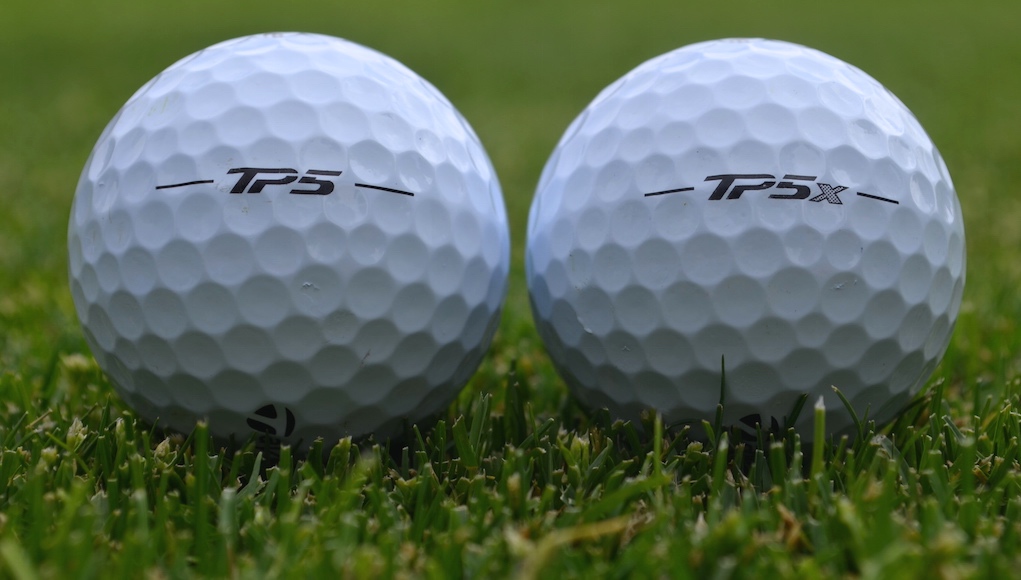
For years now, TaylorMade has been preaching lower spin to create more distance, especially in its drivers. Its original SLDR driver was actually so low spinning that TaylorMade encouraged golfers to try higher-lofted club heads, or to “loft up,” so golf balls wouldn’t dive out of the air. Now, when you look around at the popular drivers in the industry, most of them are designed to lower spin. TaylorMade was ahead of the curve.
With its new TP5 and TP5x golf balls, TaylorMade is pushing a similar initiative: lower spin on all full shots.
“This ball is different. You can make the argument this is too hot a golf ball for people who don’t spin it (enough). But that’s not the large percentage of golfers.”
For driver shots, it’s easy to understand the benefit of lower spin as long as the golfer launches it high enough. Low spin plus high launch equals more distance; that’s just a math equation. But with golf balls, as opposed to drivers, their jobs are also to get close to the hole, not just go as far and straight possible. With that in mind, is lower spin necessarily beneficial on ALL full shots, including the irons?
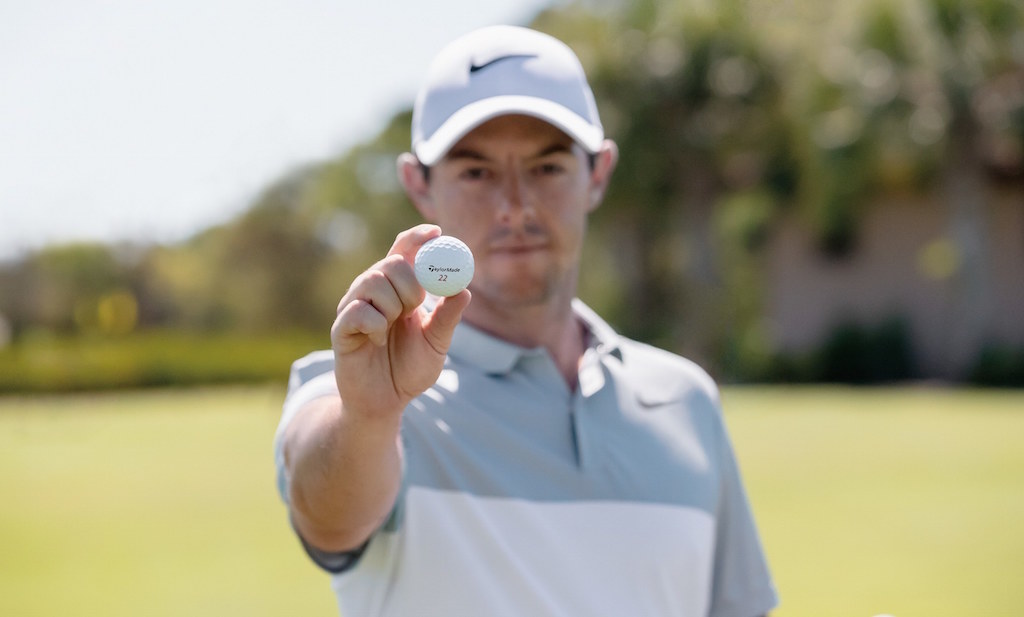
For Jon Rahm and Rory McIlroy, who both switched to TaylorMade TP5x golf ball this season — the lower-spinning and slightly firmer-feeling golf ball in the TP5 line — the answer is clearly “yes.” Rahm saw an 800 rpm drop in iron spin with a 4-iron compared to his Titleist’s Pro V1x golf ball and a 400 rpm drop in driver spin, according to TaylorMade. McIlroy saw up to 10 yards in extra distance with a 5-iron, and he picked up distance with the driver, as well. According to Eric Loper, Director of Golf Ball R&D at TaylorMade, McIlroy was hitting his 7 iron at 16.1 degrees of launch with 6350 rpm, and his 4 iron at 11.1 degrees of launch with 3800 rpm during his initial Trackman testing at The Bear’s Club.
“(With a 7 iron) you have to hit it about 7000 (rpm) or less, and he was hitting (his previous ball) up to 7500 (rpm),” Loper said. “That’s too high… (With the TaylorMade TP5x) he didn’t express any concern with (spin being too low). It was launching high, getting to its apex and landing soft.”
Hoyt McGarity, President of True Spec Golf, an internationally renowned custom club fitter with more than a dozen locations, has seen similar performance gains with TaylorMade’s TP5x golf ball through his personal testing and his testing with Tour players. He said he’s seeing 2-3 mph more ball speed compared to other golf balls. Just as importantly, he’s seeing those gains with a higher ball flight in what he called “straight up” club tests.
“Some of the Tour players — straight up, same loft, same lie, same golf club, same everything — they would launch this golf ball almost a degree higher, which is amazing,” McGarity said. “I was seeing almost 2-3 mph more ball speed for these Tour players, not that they need more distance, but I’m like, ‘You’re launching higher and it’s going further and it’s still coming in soft; it’s not coming in low and hot. It’s coming in high and still soft, so what’s the disadvantage?’ If you’re a low-ball hitter with low spin, you might have some issues. Your half shots might be tough to control the distance on it, that’s all.”
So while TaylorMade’s TP5 and TP5x golf balls are designed to go farther and with less spin on full shots, the company says their steeper landing angles will help them stop nearly as fast as higher-spinning balls. TaylorMade’s belief is based on the company’s scientific bounce-and-roll calculations, which factor in green conditions and landing characteristics. Yes, the lower spin of its golf balls in relation to competitors leads to minimally more roll out, but the amount is insignificant according to TaylorMade: an additional 1-1.5 feet. The company also points out that with a longer-flying golf ball, golfers will be hitting shorter clubs into greens, leading to more control. An 8 iron will yield greater stopping power and accuracy than a 7 iron, right?
Expert fitter Scott Felix of Felix Clubworks agrees with TaylorMade in theory. He said that as long as the golf ball is coming into a green at a steep enough angle, low spin is not a problem for approach shots.
“Most golfers spin the ball too much with their irons, costing them distance,” Felix said, “…but for golfers who already have a flat trajectory (with their irons), lowering spin won’t help them hold the green.”
McGarity added that about 80 percent of golfers who come to him for a fitting spin the ball too much, and for Tour players, the drop in spin won’t have a detrimental effect.
“Lets say the average spin on Tour is 6,000 (rpm with a 6 iron); it’s not like [TaylorMade’s TP5x golf ball is spinning] around 4,000 (rpm),” McGarity said. “If your average land angle is 49 degrees, they’re hitting these balls at say 5800 spin, which I think is great, and with a 50-degree land angle, so what’s the harm? It’s not like it’s coming in at 44 degrees; that’d be probably a one hop over the back and get into a little trouble.”
On the other hand, Felix notes that some Tour players simply want maximum control from a golf ball due to firmer fairway and green conditions, so lowering spin isn’t always the best option for them. But for average golfers, the distance gains will be beneficial.
“Most golfers aren’t playing in Tour conditions and will simply benefit from hitting the ball farther and having shorter irons into the green,” Felix said.
McGarity also warns golfers who already play low-spinning irons and drivers, and who spin the ball below 2,000 rpm with the driver, that the TP5 and TP5x golf balls may not be for them.
“This ball is different,” McGarity said. “You can make the argument this is too hot a golf ball for people who don’t spin it (enough). But that’s not that large percentage of golfers.”
After announcing an equipment contract with TaylorMade at The Players Championship, Rory McIlroy called TaylorMade’s TP5x golf ball the most important factor in his decision to sign with the company. With the new ball, he said he not only picked up distance, but consistency and control in the wind.
“I wasn’t really happy with the golf ball I was playing, and I needed to do something,” McIlroy said. “I felt like I struggled in the wind. So I sort of went back to the drawing board and tested for about 10 days pretty extensively after Augusta … I worked with the TaylorMade guys one day and started just on Trackman on the range and saw stuff with the golf ball … I thought, ‘Wow, this is what I need.’ This is exactly the thing that I’ve been struggling with.”
McGarity’s experiences confirmed McIlroy’s sentiments.
“I picked up a half club and I sit around and hit balls all the time on Trackman, so for me to pick up a half a club, it’s not the club it has to be the ball,” McGarity said. “And into the wind I can definitely see it’s more penetrating. I’m not a super high-spin player, so some shots I’ll hit the ball farther than I expected, but I’d rather have that issue than (to hit it) short.”
So there’s agreement that the ball spins less, goes farther and performs better in the wind with irons. But when fitting a golf ball, is iron play even the best place to start? Golf is about more than just iron shots, after all.
For Felix, a ball fitting begins by having a client hit “a bunch” of different golf balls on the putting green to narrow it down to a few based on feel preferences. Then he has the golfer take those golf balls to the chipping green and bunker. He then works back to 40-yard shots, narrowing down the options throughout the process based on feel and performance. After that, golfers will progress to the driver, and then to the irons.
“Usually you want to get a few balls you really like on and around the greens, then work backwards from there,” Felix said.
Initial testing for McIlroy started on the golf course, and not on Trackman, according to TaylorMade representatives. Once he became comfortable with performance and feel, he then took to Trackman to get dialed in with spin and match the golf ball to his equipment.
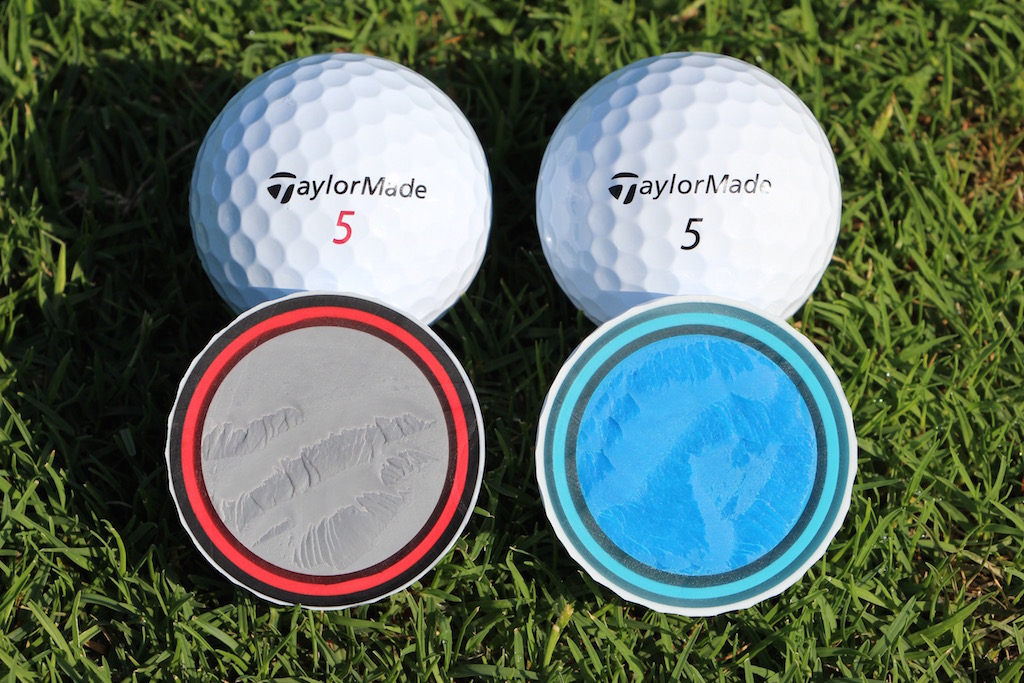
TaylorMade’s TP5x and TP5 golf ball (right), which has a slightly firmer feel.
Despite the low-spinning qualities of the golf balls on full shots, TaylorMade believes it’s giving up nothing to the competition in terms of short game performance. “There’s no golf ball that spins more around the greens,” a TaylorMade representative told me. That’s a legal way of saying no other golf ball company can prove, with confidence, that its golf ball spins more around the greens.
By producing extremely low spin on full shots, but without giving up performance and feel around the greens, TaylorMade says it’s providing the best qualities from each end of the spectrum with its TP5 and TP5x golf balls. But… how? TaylorMade engineers accomplished the feat by using larger and softer-compression cores. TaylorMade says the cores “activate” at 70 mph of swing speed inside of the five-piece constructions, which also have firm mantle layers and soft, urethane covers. The result is low spin on full shots, and high spin on shorter shots.
“It’s the real first golf ball (TaylorMade has) made that’s a game changer,” McGarity said.
TaylorMade does admit, however, that golfers may be sacrificing a bit of “workability” with the irons. That’s to say hitting hooks and slices with its golf balls becomes more difficult due to the lower spin. While the TP5 will offer a bit more of that control than the TP5x, it’s definitely something to keep in mind for those who prefer to play a Bubba Watson-style of golf.
Looking to the future
So does all of this mean that lower-spinning golf balls on full shots are the future of golf? Will we see golf equipment companies striving for drastically lower spin over the next few years?
TaylorMade representatives say they continue to chase lower spin in their prototyping, and until the golf ball is diving out of the air to the golfer’s detriment, lower spin is the future of golf balls. Obviously, TaylorMade is fully committed to a lower-spinning golf ball, and lower spin in general throughout its product lines.
For other premium golf ball manufacturers, bringing lower-spinning options to the market seems likely, given the performance benefits and Tour validation of TaylorMade’s new golf balls. But there’s a reason there are so many variations of golf balls on the market; every golfer is different. Some need more spin with the driver and want more workability with the irons, some want a super firm feel and others just want the cheapest ball possible.
Golfers should view TaylorMade’s TP5 and TP5x golf balls as options in the vast marketplace of golf balls, and perform thorough testing to figure out if this is the right line of golf balls for their game. And remember, lower spin and more distance will require recalibrating your iron distances, and possibly adjusting your equipment, so a mid-season switch is recommended only to those who are willing to put in the necessary work.
- LIKE311
- LEGIT52
- WOW18
- LOL8
- IDHT2
- FLOP6
- OB2
- SHANK79
Ball Reviews
Review: Callaway Chrome Soft X Golf Balls
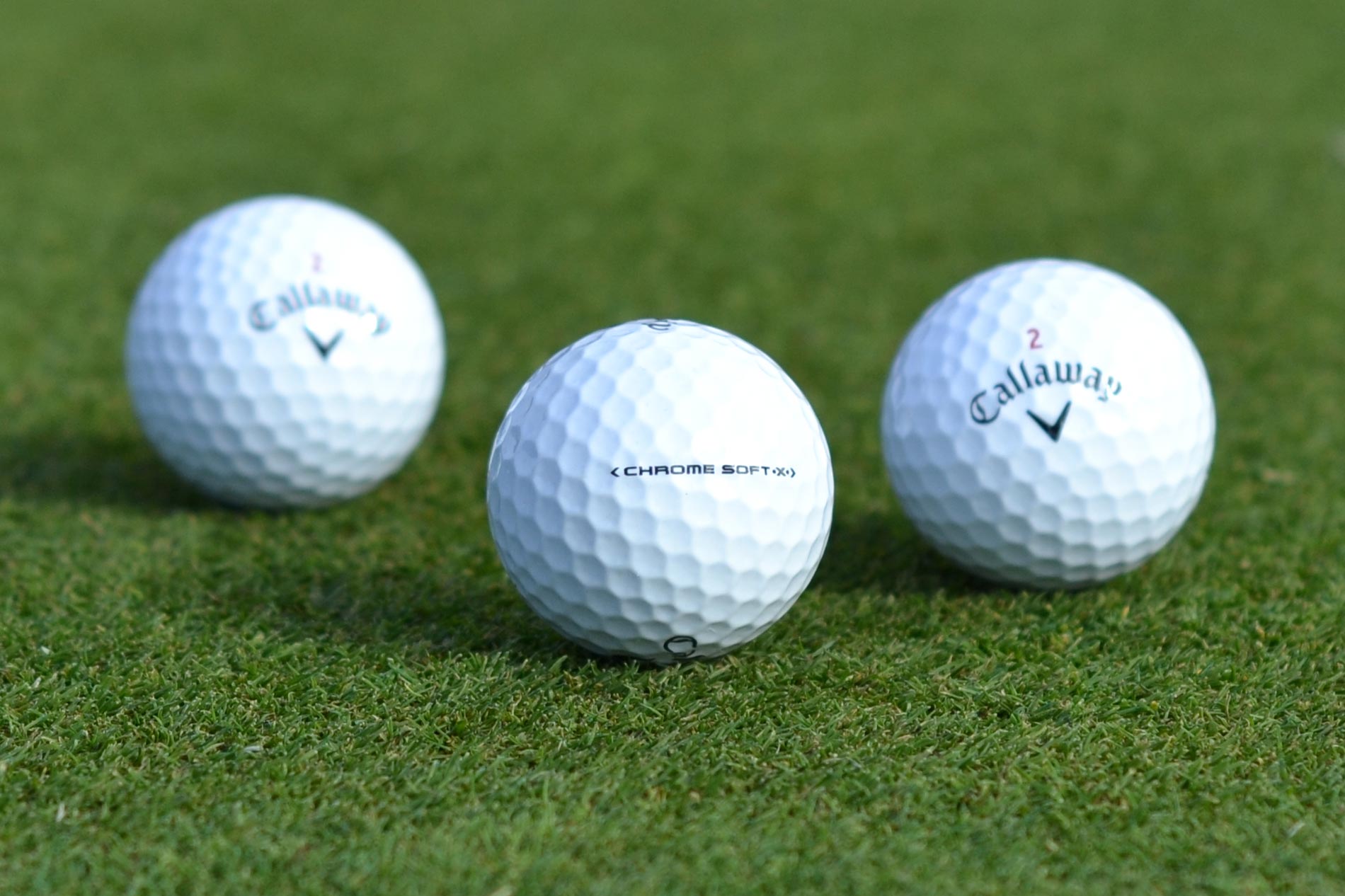
Pros: Incredibly soft feel like the Chrome Soft, but the Chrome Soft X increases spin through the bag to give better players more control.
Cons: Golfers who struggle with too much slice or hook won’t find it any easier to keep shots close to the target with the Chrome Soft X.
Who They’re For: Better players with higher swing speeds looking for a soft-feeling ball that checks up faster with iron shots than Chrome Soft.
The Review
Callaway says the Chrome Soft is “the ball that changed the ball,” and in many ways that’s true. It’s a tour-level golf ball with a softer feel, less spin through the bag and even a lower price point ($39.99) than some other tour balls in its category.
The Chrome Soft is Callaway’s best ball option for the vast majority of golfers (and received a 5-star rating by GolfWRX), but it isn’t for everyone. Callaway’s solution for them is its new Chrome Soft X golf ball.
What’s New in the Chrome Soft X
The original Chrome Soft golf ball, launched in 2015 had the very soft compression of 65. When Callaway released the 2016 version of Chrome Soft, it gave the ball a slightly higher compression (75), which improved its consistency on short-iron shots. The compression of its new Chrome Soft X is 90.
The reason for the higher compression has to do with the low-spin profile of the Chrome Soft, a blessing to most golfers as it helps their shots fly straighter and farther. It’s not ideal for some tour pros and better golfers, however. We’re talking about the kind of golfers who have great mechanics and strike shots consistently on the center of the club face. They often have a ball flight that is so dialed in that the lower-spinning performance of the Chrome Soft makes their shots harder to control. To address that small but important segment of the golfing population, Callaway created the higher-spinning Chrome Soft X.
Under the hood, Callaway used a slightly thinner urethane cover, increased the size and hardened the compression of the Dual SoftFast core, and enhanced the HEX Aerodynamics. As a result, the Chrome Soft X should generate more ball speed and spin through the entire bag.
Dave Bartels, Callaway’s Senior Director of Golf Ball R&D, says golfers will be able will notice the differences and have a clear favorite. “We expect that golfers who like the Chrome Soft X probably won’t like the Chrome Soft very much, and vice versa.”
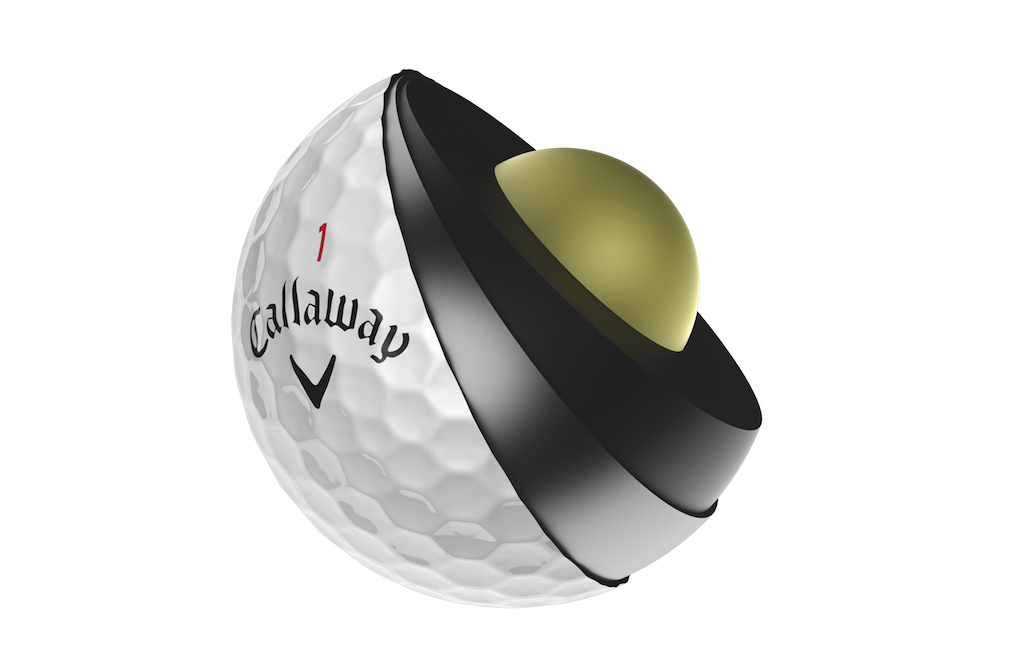 The Chrome Soft X ($39.99) will be in stores February 3 in White and Yellow.
The Chrome Soft X ($39.99) will be in stores February 3 in White and Yellow.
Performance
Since the Chrome Soft X is meant to be a complimentary golf ball to the Chrome Soft, we tested them head-to-head.
Compared to the Chrome Soft the Chrome Soft X should:
- Feel almost as soft as the Chrome Soft with the same durability.
- Generate more spin where better golfers need it.
- Generate faster ball speeds.
Like previous reviews, I tested these on the course and on a launch monitor with a 60-degree wedge, 6-iron and a driver. To allow me to re-hit each ball numerous times, I completed the testing indoors on a camera-based SkyTrak launch monitor. To keep the numbers as consistent as possible between the balls, I threw out and re-hit any shots that were not struck on the center and did not land within a designated target zone for each club (Wedge: +/- 3yards, 6 Iron: +/- 8 yards, Driver: Target width of 40 yards).
But I’m not a robot, so take that into account.
60-degree full wedge shots
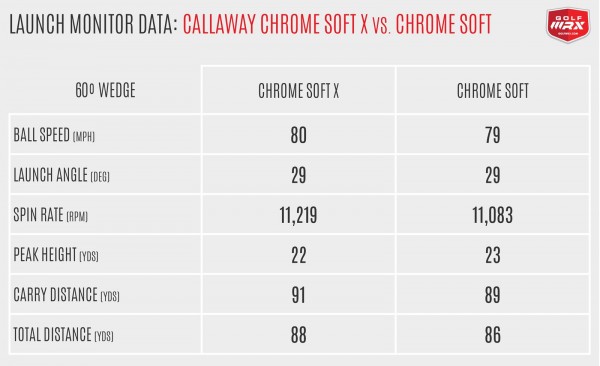 Main differences we expect to see: Not many. If anything, the Chrome Soft X might generate slightly higher ball speeds.
Main differences we expect to see: Not many. If anything, the Chrome Soft X might generate slightly higher ball speeds.
What the data actually shows: Pretty much as expected. Overall, the Chrome Soft X clocked 1 mph more ball speed, 136 rpm more spin and carried 2 yards farther. These are very subtle differences, and for an amateur like me I would not expect to notice a difference on the course.
The larger Dual SoftFast core and higher compression could account for the additional ball speed and carry distance. For me, 2 yards won’t require much of an adjustment. If you are a better player completely dialed in with your distances, you might need to make a minor adjustment.
What I saw on the course: When I’m testing golf balls, I like to drop one down without looking at the label and hit a shot. This allows me to remain unbiased in my expectation and just watch what the ball does. When I did this test with the Chrome Soft X on a full wedge shot, I was instantly impressed. The feel was incredible and the distance was spot on. After the wedge testing, I would’ve put this ball straight in the bag.
6-iron shots
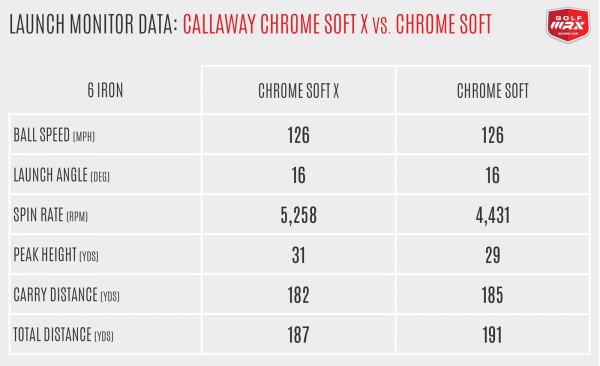 Main differences we expect to see: The Chrome Soft X should generate faster ball speeds and more spin than the Chrome Soft.
Main differences we expect to see: The Chrome Soft X should generate faster ball speeds and more spin than the Chrome Soft.
What the data actually shows: The Chrome Soft X is continuing to spin more through the bag. Ball speeds were slightly higher by about 0.8 mph. The Chrome Soft X generated a considerable amount of additional spin, but also flew slightly higher and had a steeper descent angle.
Just like you’ll see with the driver below, the additional spin decreased my distance (the Chrome Soft X averaged 3 yards less carry and 4 yards less total distance), but increased my stopping power.
What I saw on the course: Just like previous Chrome Soft balls, the feel off the club face with mid irons was very soft. I really noticed the additional spin on the course, as my draw shot shape started to get a little more curve to it and my shots stopped faster on the greens. I felt like I was able to attack greens with longer irons, flying shots all the way to the hole instead of playing a little short and letting the ball release more.
Driver shots
Main differences we expect to see: The Chrome Soft X should spin more slightly more and deliver higher ball speeds than the Chrome Soft.
What the data actually shows: I am not a high swing-speed player. My average playing swing speed is around 105 mph, which is generally considered the cut-off before you have a “high swing speed.” Also, I am not a low-spin player, so having a ball that can spin a little more might not be the best for my specific game. Based solely on that, I would not expect to see the full benefits of the Chrome Soft X
The testing backs this up. The Chrome Soft X delivered the same ball speed, but with 432 rpm more spin. Bartels says Callaway’s testing has shown golfers either spinning the Chrome Soft and Chrome Soft X the same off the tee, or an increase of 100-200 rpm with the Chrome Soft X. He called 400 rpm “within the ballpark,” but not typical.
Just to be clear, we’re talking about a change in performance that resulted in just 1 yard less carry distance and 3 yards less total distance; basically nothing.
What I saw on the course: As my launch monitor data showed, the Chrome Soft X appeared to fly higher and not roll as much when it hit the ground.
The one place I saw a benefit to the Chrome Soft X was when I contacted a drive high off the club face. With the Chrome Soft, these drives fell out of the sky more quickly, costing me carry distance. With the Chrome Soft X, they stayed in the air a little longer. It’s clear for low-spin players, or those with already optimal launch conditions, the Chrome Soft X can provide as good, if not better performance.
Around the Green
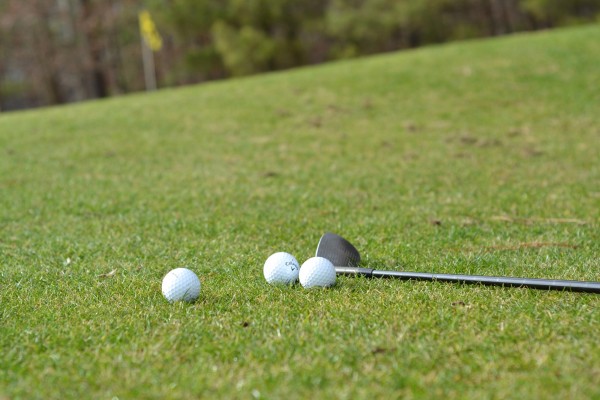 There is nothing this ball can’t do around the greens. I don’t have a tour pro’s arsenal of short game shots, but I do know the difference between a ball that can do anything and a ball that can do only some things.
There is nothing this ball can’t do around the greens. I don’t have a tour pro’s arsenal of short game shots, but I do know the difference between a ball that can do anything and a ball that can do only some things.
I put the Chrome Soft X through the paces of low spinners, high flop shots, bump and runs, and bunker shots. As expected, it performed identically to the Chrome Soft.
Putting
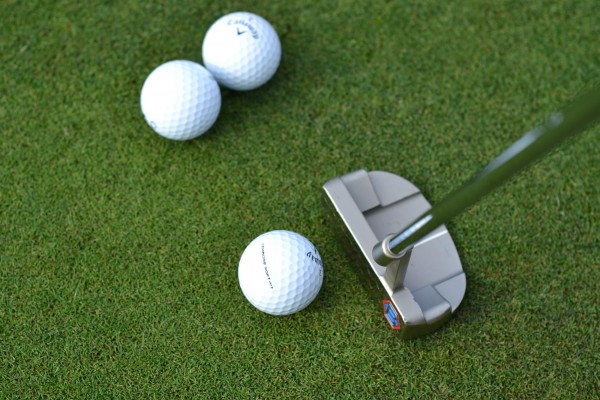 Putting one right after the other, if you are really paying attention, the Chrome Soft X feels slightly firmer off the putter face with a slightly higher-pitched sound than the Chrome Soft. But this ball is soft, smooth and rolls beautifully. I have always loved the way the Chrome Soft feels off the putter, going back to the 2015 ball. Even though it’s slightly firmer, the feel off the putter of the new Chrome Soft X continues to impress me (through the entire bag really).
Putting one right after the other, if you are really paying attention, the Chrome Soft X feels slightly firmer off the putter face with a slightly higher-pitched sound than the Chrome Soft. But this ball is soft, smooth and rolls beautifully. I have always loved the way the Chrome Soft feels off the putter, going back to the 2015 ball. Even though it’s slightly firmer, the feel off the putter of the new Chrome Soft X continues to impress me (through the entire bag really).
Feel is subjective, but I found the Chrome Soft X to be one of the softest tour balls on the market today.
Durability
I completed all my testing with only one ball, so it saw a considerable amount of shots. Like previous Chrome Soft balls, the Chrome Soft X is very durable. It took a beating with the 60-degree and showed only light scuff marks. Both the Chrome Soft X and the Chrome Soft perform very similarly in terms of durability.
The Takeaway
The Chrome Soft X isn’t for everyone and that is why Callaway is marketing the “X” as a complimentary ball to the Chrome Soft and not a replacement.
With the changes Callaway has made, the Chrome Soft X checks off all the criteria for a high-performance premium golf ball. If you thought the 2016 Chrome Soft was a little too soft with too little spin through the bag, the Callaway Chrome Soft X might just be the ball you’re looking for.
- LIKE294
- LEGIT43
- WOW14
- LOL8
- IDHT4
- FLOP8
- OB3
- SHANK25
Ball Reviews
Review: Callaway Chrome Soft golf balls
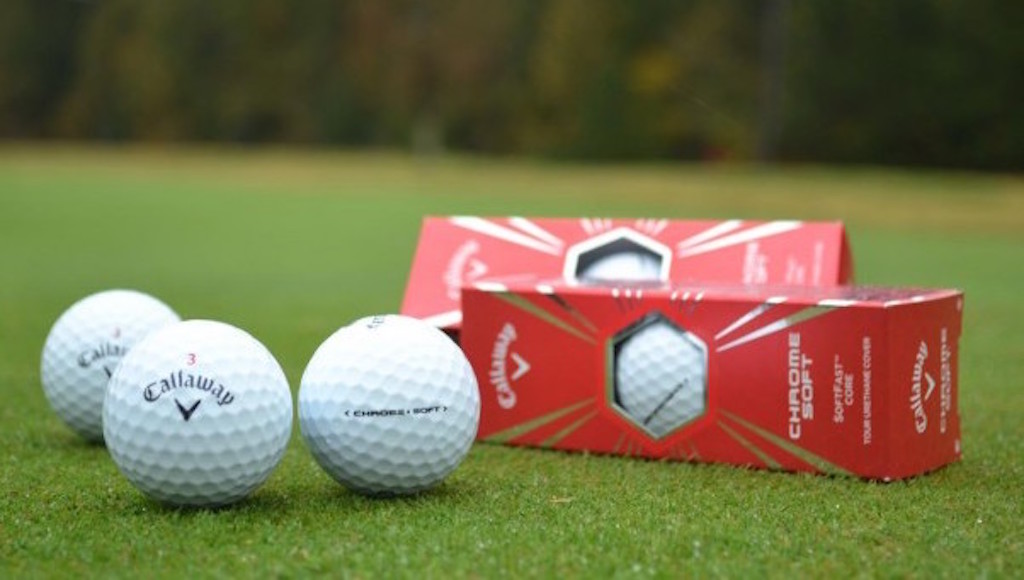
Pros: The Chrome Soft has an incredibly soft feel, but doesn’t skimp on performance. It will create maximum distance off the tee for 99 percent of golfers, yet offers short-game spin that rivals more expensive models.
Cons: Golfers with high swing speeds (105+ mph) — a.k.a. the 1 percent — may lose a few yards off the tee due to the Chrome Soft’s low-compression design.
Who They’re For: Any golfer can play the Chrome Soft.
The Review
Last year, Callaway released the Speed Regime golf ball line, which offered three different golf balls designed for different swing speeds, all with slightly different levels of compression and design. While this gave golfers the ability to really “fit” a golf ball to their game, more choices doesn’t always translate into better decision-making.
With its new Chrome Soft golf balls, Callaway has released just one ball, with one set of specifications, designed to provide a benefit to all golfers regardless of their swing speed.
The three-piece Chrome Soft, with a low-compression Soft Fast core and extremely soft DuraSpin cover, generates lower spin off the driver and long irons for more distance, while generating tour-level spin with shorter irons and shots around the green.
Let’s Talk Core
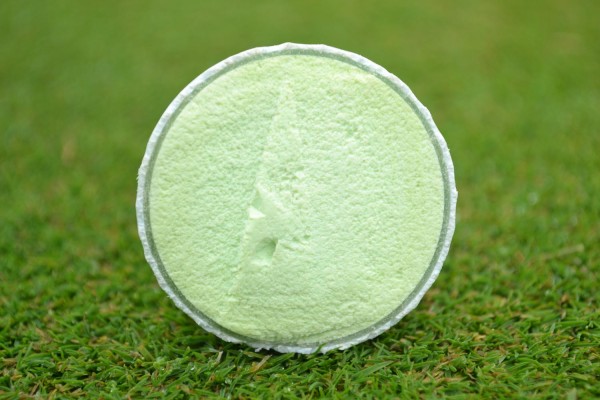 The Chrome Soft is all about the core, and since Callaway is devoting advertising space to actually talking about the compression of the golf ball, let’s dig into it a bit more.
The Chrome Soft is all about the core, and since Callaway is devoting advertising space to actually talking about the compression of the golf ball, let’s dig into it a bit more.
Thanks to a brand new SoftFast core, as Callaway calls it, the ball has a compression rating of 65. By comparison, last year’s Callaway SR-3 had a compression of around 105. Typically, the softer the core, the more the ball deforms at impact. This is great for slower swing speed players who need the ball to deform more so it can spring back into shape and generate more distance. But faster swing speed players can actually lose distance if the ball is too soft. After experimenting with 39 different prototypes, however, Callaway was able to create the right combination of the core and mantle layer so the Chrome Soft retains the energy from impact and keeps ball speed high — even at faster swing speeds.
The Chrome Soft is available now in White, Soft Yellow and Truvis Technology with an MSRP of $37.99. Custom player numbers and personalization is also available.
Performance
We put the new Chrome Soft to the test against the Callaway Speed Regime SR-3, which I tested last year.
Compared to the Speed Regime line the Chrome Soft should:
- Feel softer off every club, with slightly better durability.
- Generate less spin off the driver.
- Create more spin off shorter irons.
Like all reviews, I tested these on the range, on the course, and on a launch monitor with a 60-degree wedge, 6-iron and a driver. I headed to BridgeMill Golf Academy and worked with head pro Tom Losinger to get the data using a Trackman in his indoor studio.
60-degree full wedge shots
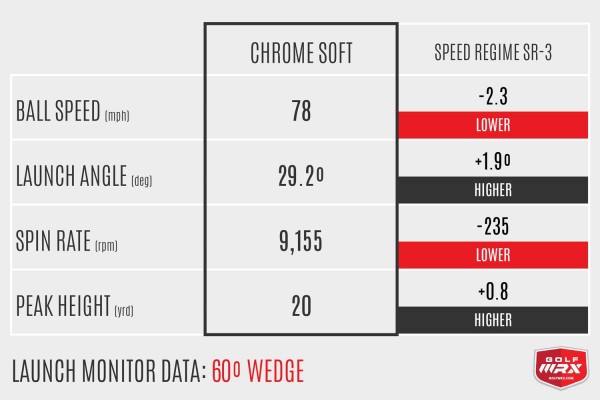
Main differences we expect to see: The Chrome Soft should generate more spin on full wedge shots.
What the data actually shows: Exactly what we expected to see. The Chrome Soft generated 200 rpm more spin than the SR-3, while launching lower and hitting a slightly lower peak height. I did, however, see a big difference in ball speed and carry distance, with the Chrome Soft flying three more yards on average.
Increased ball speed or carry distance with the shorter irons is not typically on the list of requests from better players. In this case, it’s a by-product of the new SoftFast core and three more yards of carry with a 60-degree wedge is fairly significant. That 10-foot putt for birdie is now almost 20. These types of gains will require an adjustment.
What I saw on the course: This ball was perfect inside 100 yards. If it was flying farther than other balls I’ve played, I didn’t notice. The trajectory on full wedge shots was nice and low compared to other balls, and I was already able to notice a difference in feel between the Chrome Soft and the SR-3. A difference of 200 rpm of spin wasn’t noticeable on the course, as both balls performed very similarly when they hit the green.
6-iron shots
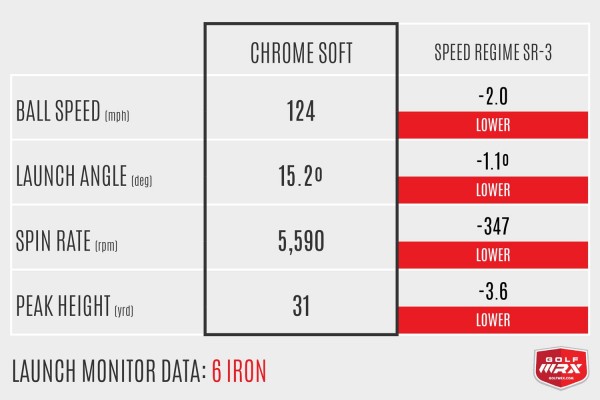
Main differences we expect to see: The Chrome Soft should generate faster ball speeds and less spin than the SR-3.
What the data actually shows: The data backed up the expectations when it came to ball speed. However, I actually saw more spin on my 6-iron compared to the SR-3 and even other tour balls. This could be due to a variety of factors concerning my individual swing, and other golfers might see less spin off their mid irons. Compared to the SR-3, the Chrome Soft launched a little higher, with more spin and ball speed, allowing it to carry a little more than one yard farther. It also hit a higher peak height with a steeper descent angle.
What I saw on the course: I was probably most impressed with the Chrome Soft with the mid to long irons. Yes, the ball performed great off the driver, but the softer feel was very apparent with an iron in my hands. Launching shots with mid to long irons had a more effortless feel. I was also able to get some nice height and spin on my longer irons without sacrificing distance, so I could land shots on the green and see them stick, instead of hitting and running off the back.
Driver shots
Main differences we expect to see: The Chrome Soft should spin less, but still generate more ball speed than the SR-3.
What the data actually shows: I’m a borderline high-speed guy with the driver. My average swing speed is around 106 mph — right on the borderline where golfers can start to “over-compress” the Chrome and possibly lose distance.
You may have read editor Zak Kozuchowski’s reviews on GolfWRX, who can generate more than 115 mph of swing speed with his driver. In his on-course testing, he said he hit the Chrome Soft about the same distance as other tour balls.
“If they liked everything else about the ball, I can’t imagine a golfer who swings 105+ mph wouldn’t play the Chrome Soft just because it was a few yards shorter than a higher-compression tour ball off the tee,” he said. “If a soft feel is important to them, that’s going to take precedence over a few yards of extra distance. And they’ll get those few yards back with their long irons, anyways.”
In my testing, the Chrome Soft generated slightly faster ball speeds, and a lot less spin — almost 300 rpm less spin than the SR-3. This translated into an extra 1.5 yards of carry, and more than 5 extra yards of total distance.
What I saw on the course: The distance gains and lower spin appeared to translate to the course. I wasn’t having any issues getting the ball to run out once it hit the fairway. And the distance appeared to be spot on, if not slightly longer.
Around the green
It is always fun to have that moment in a round where you hit the low, checking chip that freaks out your playing partners. I had that moment from about 55 yards away to a back pin, with out of bounds directly behind the green. With a 56-degree wedge, I hit the low shot and right before the ball hit the green, my playing partners were yelling “get down!” But I knew I hit it well and the ball bounced, checked, and then just lipped the cup.
Could I have executed that shot with other tour balls? Yes. But, it is important to know I can execute it with the Chrome Soft. I’m not a short-game wizard like one of Callaway’s more well-known tour pros, but these balls allow me to hit any kind of shot around the green without hesitation.
Putting
The Chrome Soft feels much softer than the SR-3, which was noticeably softer than previous generation Callaway tour balls. The sound profile has a lower, less “clicky” sound that translates into improved feel. The engineers really have brought the incredible feel of the SuperSoft to the tour-level Chrome Soft.
I’ve rolled some beautifully smooth putts with these balls. They are predictable and roll true when you strike them well. While I won’t go so far as to say they are the best feeling golf ball on the market (although they are close), they are the best feeling Callaway golf ball I’ve tested.
Durability
When most people hear “softer cover,” they instantly assume it will be less durable — and for good reason. It is counter intuitive to believe that soft equals durable. I’m not going to pretend to know the science behind it, but the DuraSpin cover is made from Thermoplastic Urethane, which actually becomes more durable the softer it gets.
I’ve played numerous rounds with the same ball, and also completed all the testing with only three Chrome Soft golf balls, so I can back up Callaway’s claims. These balls are definitely durable and can last numerous rounds if you don’t lose them. With fresh wedge grooves, I was getting all the spin benefits and little to no scuffing. I did see some minor scuffs after finding some rocky rough off the tee, but the ball was still playable and I shouldn’t have been over there in the first place!
The Takeaway
If you’ve avoided Callaway balls in the past because of the “clicky” stigma that has followed them around, it might be time to try a sleeve of the Chrome Soft. Many golfers, myself included, really love the feel of the Callaway SuperSoft, but not the overall performance. The Chrome Soft is a marriage of the soft feel of the SuperSoft with the tour-level performance of the Callaway SR-3. With low spin off the driver and the most spin on short irons of the tour balls I’ve tested this year, the Chrome Soft is one of the best golf balls on the market today.
We gave the Chrome Soft 5 stars, but one of our editors made the case that on a scale of 1-10, the Chrome Soft is an “11.” If you’ve seen the movie Spinal Tap, you know what he means.
See what GolfWRX Members had to say about the Chrome Soft in our Official Forum Testing Thread.
[wrx_retail_links productid=”12″]
- LIKE267
- LEGIT34
- WOW18
- LOL3
- IDHT5
- FLOP1
- OB2
- SHANK24
-

 19th Hole1 week ago
19th Hole1 week agoDave Portnoy places monstrous outright bet for the 2024 Masters
-

 19th Hole3 weeks ago
19th Hole3 weeks agoThings got heated at the Houston Open between Tony Finau and Alejandro Tosti. Here’s why
-

 19th Hole1 week ago
19th Hole1 week agoTiger Woods arrives at 2024 Masters equipped with a putter that may surprise you
-

 19th Hole2 weeks ago
19th Hole2 weeks agoReport: Tiger Woods has ‘eliminated sex’ in preparation for the 2024 Masters
-

 19th Hole4 days ago
19th Hole4 days agoTwo star names reportedly blanked Jon Rahm all week at the Masters
-

 19th Hole4 days ago
19th Hole4 days agoNeal Shipley presser ends in awkward fashion after reporter claims Tiger handed him note on 8th fairway
-

 19th Hole3 days ago
19th Hole3 days agoReport: LIV Golf identifies latest star name they hope to sign to breakaway tour
-

 19th Hole2 weeks ago
19th Hole2 weeks agoAddiction, spinal fusion, and scam artists – Everything Anthony Kim revealed in candid interview with David Feherty


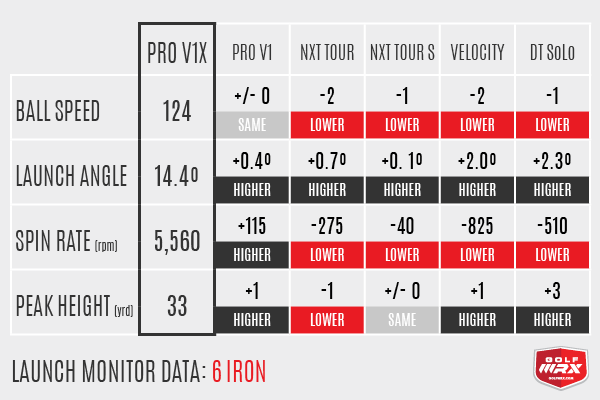
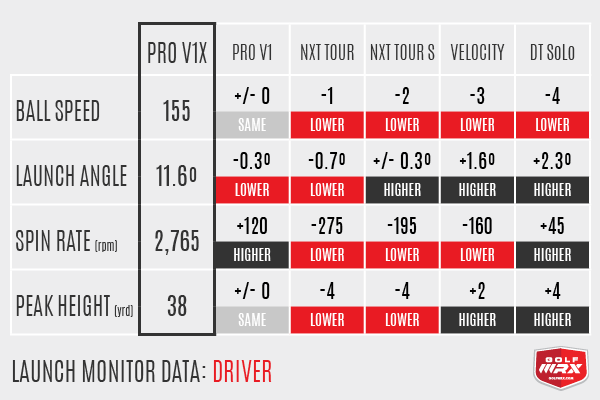
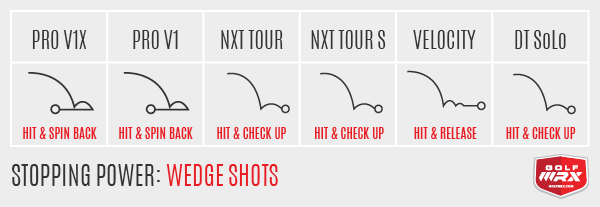
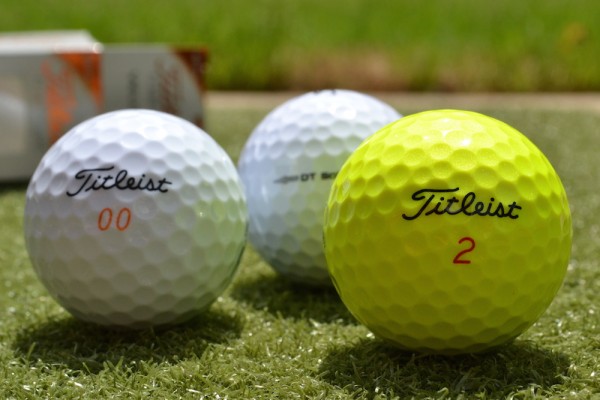
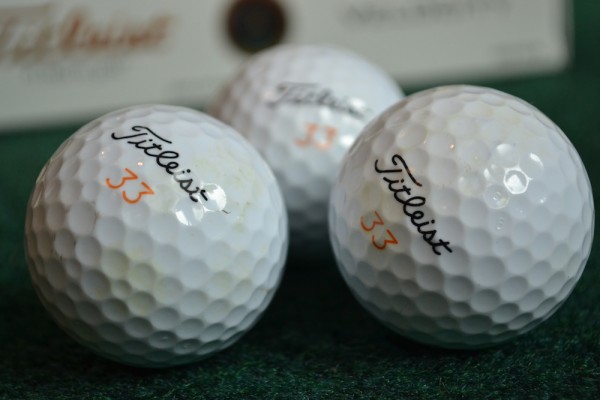
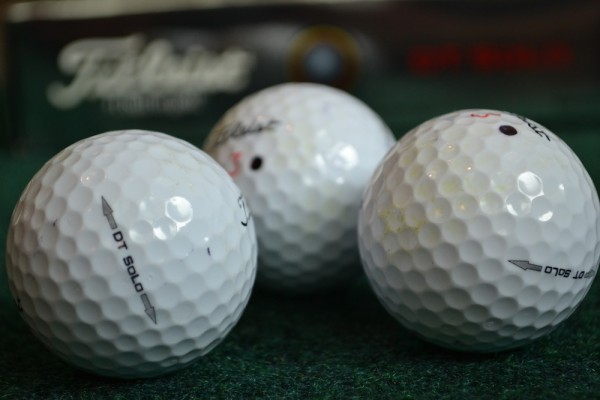


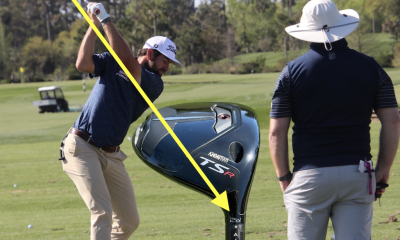

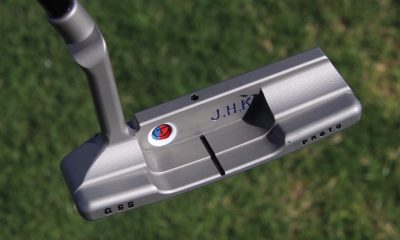



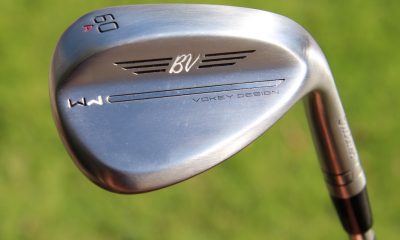

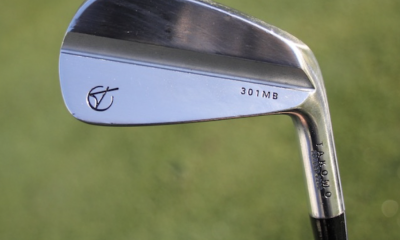





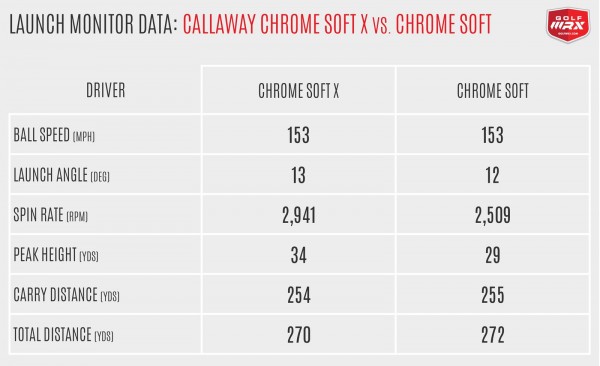
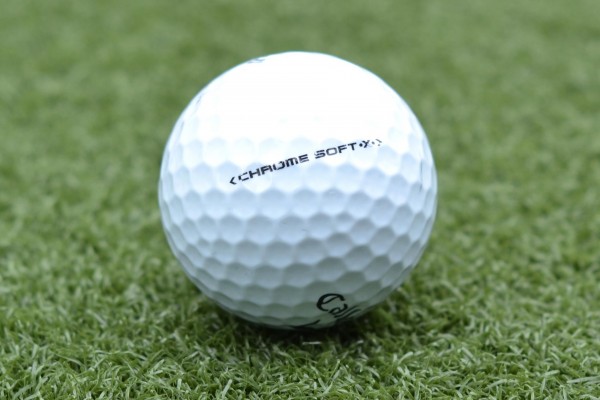
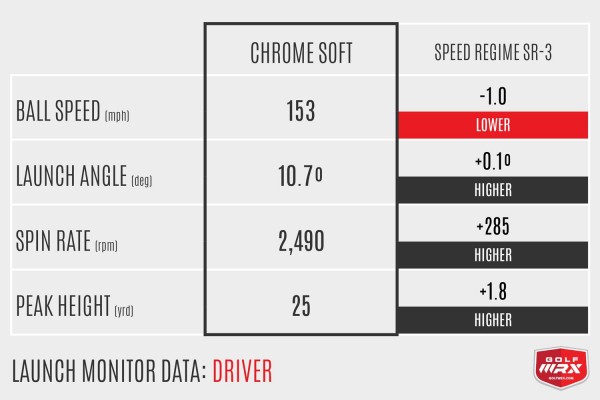
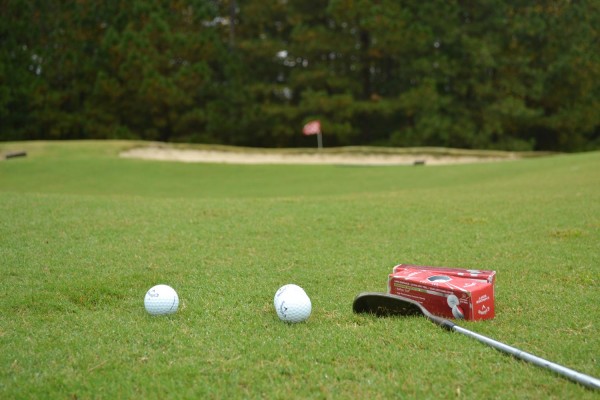
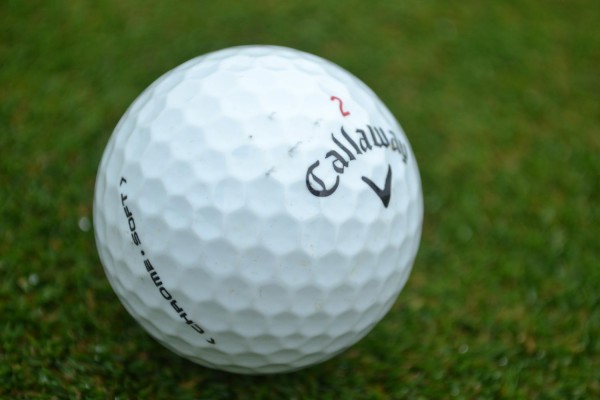













Pete
May 29, 2016 at 3:34 am
Tried the velocity against the nxt tour today with the velocity preforming well. Picked up 10-15 yards off the tee and 5-10 on the fairway, lower spin made hitting fairways much easier.
CB
Feb 22, 2016 at 2:04 pm
Curious to get your thoughts on the best ball for me. I generate a lot of spin off my driver and very little roll (high cut). swing speed 105. 9 hcp index. I’m a big guy so my tendency is over the top as u can imagine. I’d trade being straighter off the tee w/ some roll vs softness around the greens.
Vince
Jun 26, 2015 at 8:13 pm
Fine article. Very helpful. Good data. Good insight. Thank you very much.
Pingback: Titleist Golf Ball Reviews Ratings | Gunner Golf
killerbgolfer
Jan 10, 2015 at 11:38 am
I just tried the Velocity yesterday for 9 holes. Weather was about 40* and the course was pretty wet. The ball felt decent of the tee and on full iron shots it stopped pretty quick. I could not get it to stop rolling when chipping though and it came off the putter pretty hot. For these reasons, I didn’t use it on the back nine. It was too difficult for me to control on the short game, which cost me strokes. I went back to the Pro V1 and played 5 shots better.
Rich J
Jun 27, 2014 at 6:37 pm
Very good review! Very helpful.
It confirmed why I use the DT Solo on par3s and iron layup tee shots great bite! For driver I prefer the Prov1x but to expensive so I usually play Taylormade Burner with LDP or Brigestone E7.
Bill Nobles
Sep 1, 2014 at 2:48 pm
After spending 30 minutes on the LM, and discussing with the pro what kind of combination of firmer shaft and a ball with less spin, he mentioned the Velocity. I took these out for a round and was pleasantly surprised. Yes they seem to be a little longer, but more important, the spin rate showed up in consistently straighter drives. I had also read about the Velocity being difficult to stop off of irons into the green. Again, not an issue as I stopped the ball with everything from wedges to a five iron. At half the price of ProV1’s, I have found my ammo. Driver swing speed-96 mph, Spin rate- 2100.
Rob Courtney
May 31, 2014 at 6:09 pm
Really interesting & informative comparison. I have played both these balls & prefer the DT Solo for its softer feel and greater all round capabilities. Have recently been trying out the NXT Tour S. So far not convinced that it has much over the DT Solo.
Tre
May 15, 2014 at 10:09 pm
Love the review. Would you do a review that has the track man numbers for the top shelf balls? Pro v1/prov1x, z star/z star xv, b330/b330s, tour preferred/x
Thanks
Kane Cochran
May 17, 2014 at 11:00 am
Thanks, Tre, happy you enjoyed the review. We just reviewed the Pro V1 and Pro V1x, you can read it here: http://www.golfwrx.com/206069/review-titleist-pro-v1-and-titleist-pro-v1x-golf-balls/
And we’re planning to do additional reviews in the coming months so stay tuned for those.
advertising programs
May 14, 2014 at 8:31 am
I’m just no longer optimistic wherever you are taking your info, nonetheless good theme. I personally needs to devote more time to examining far more or even knowing more. Appreciation for fantastic info I’d been looking for these records in my objective.
Barney Boom
May 10, 2014 at 1:11 pm
I find some of the numbers strange. Lower compression balls generally spin alot less off the driver compared to higher compression balls ie: Pro V1 and Pro V1X. I can understand the loss of ballspeed at 155 mph as the core would start to strain especially the Solo .
Am I mistaken ?
Bryan
May 10, 2014 at 12:24 pm
I like the yellow balls too and wish more manufacturers offered that option.
Golfraven
May 9, 2014 at 3:48 am
nice review. I might give DT SoLo a try and see how it can keep up with NXT Tour S I currently play. Probably good ball for the off season when I tend to loose more balls that I like
Ked
May 9, 2014 at 2:45 am
Just as I suspected. The Next Tour S is the best ball that Titleist makes. You’re all wasting money on the Pro V1-X.